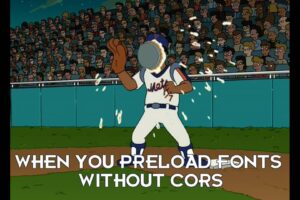For the first episode of my WRAPS series, I reviewed the homepages of the 18 men’s Bundesliga football teams. The results are mixed, or to put it positively: there is still a lot of potential for improvement, and an unexpected winner emerged.
The Results
The evaluation of the homepages is based on five criteria. A detailed explanation of the criteria and their weighting can be found here. Specific aspects that arose in this episode are explained further below.
The results show that financial resources of the clubs do not play a role in the performance and sustainability of their websites. In this ranking, lean and efficient solutions triumph. Auto-playing videos or slideshows in the AtF almost always have a negative impact on the UX and the ecological footprint of the websites.
| # | Team | TOTAL | Carbon | CWV | A11y | Privacy | Content |
|---|---|---|---|---|---|---|---|
| 1. | 1. FSV Mainz 05 | 78.63% | 97% | 100% | 56% | 27% | 90% |
| 2. | FC St. Pauli | 78.11% | 63% | 100% | 96% | 60% | 65% |
| 3. | RB Leipzig | 77.26% | 87% | 92% | 58% | 80% | 65% |
| 4. | TSG Hoffenheim | 74.34% | 70% | 100% | 80% | 60% | 75% |
| 5. | Eintracht Frankfurt | 73.18% | 92% | 73% | 40% | 67% | 45% |
| 6. | VFL Wolfsburg | 73.12% | 57% | 100% | 57% | 33% | 90% |
| 7. | Borussia Dortmund | 70.35% | 63% | 90% | 63% | 77% | 40% |
| 8. | FC Augsburg | 65.58% | 59% | 77% | 65% | 57% | 90% |
| 9. | FC Bayern München | 64.48% | 49% | 78% | 79% | 60% | 65% |
| 10. | VFB Stuttgart | 62.70% | 81% | 67% | 47% | 30% | 75% |
| 11. | Bayer Leverkusen | 58.72% | 63% | 39% | 60% | 67% | 90% |
| 12. | VFL Bochum | 55.19% | 67% | 48% | 47% | 54% | 45% |
| 13. | SC Freiburg | 52.55% | 35% | 67% | 82% | 20% | 90% |
| 14. | 1. FC Heidenheim | 51.95% | 28% | 100% | 31% | 54% | 75% |
| 15. | Werder Bremen | 51.11% | 39% | 61% | 75% | 20% | 65% |
| 16. | Borussia M’gladbach | 50.83% | 41% | 60% | 50% | 57% | 65% |
| 17. | Holstein Kiel | 46.40% | 0% | 100% | 41% | 7% | 65% |
| 18. | 1. FC Union Berlin | 41.36% | 9% | 97% | 53% | 0% | 90% |
The Criteria
There are a few specific points regarding the measurement and results in the individual criteria.
Carbon Footprint
My initial idea was to use the Website Carbon rating system to calculate the score. My thought was that 100% of the points would be awarded for an A+ rating, 0% for an F rating, and a linearly decreasing value in between. Unfortunately, the measurements showed that many Bundesliga homepages – especially on the first load – received an F rating. Since this would have resulted in websites receiving the same score even though one might emit half as much CO2 per page load, I decided to use the worst score of all Bundesliga teams as the 0% threshold.
I distinguish between two scenarios: the first load and repeated loads. Since many sites hardly send any caching instructions for their resources, the data load varied greatly during repeated visits. Therefore, I made several visits at different time intervals and calculated the average.
Per initial page load the homepages cause 8.3MB of data payload on average. More than 90% of all webpages globally cause a lower payload on mobile devices. I don’t see any technical reasons why this should be justified. Thus, it needs to be called wasteful.
Core Web Vitals
This is the area where the websites performed best, with an average score of 80%. The biggest issues were due to unstable page layout. Interestingly, the high data payload does not yield to long page load times, even though not many homepages utilise resource-hints or fetchPriority. Which is evidence that browsers are extremely efficient in prioritising resources on their own.
Accessibility (a11y)
Almost all websites need to make improvements to meet the EAA requirements, which will come into force in mid-2025
Four homepages (plus Holstein Kiel since the relaunch) use a third party provider to improve accessibility. However, other homepages also score points through colour choices and plain language.
Privacy
Almost all homepages initiate connections to servers whose operators are outside the EU and, therefore, are not bound by the GDPR. Personal data is disclosed through these connections (IP address, possibly browser fingerprint and Cookies). This issue needs urgent attention.
Since all homepages use third-party cookie consent management tools, I ignored these connections (with the exception of Heidenheim. They do not display any cookie notice, which is even worse.).
The lack of security on the websites presents an additional risk factor regarding data protection. Many websites lack security headers , and some use outdated JS libraries or web server software.
Content
I found this category somewhat challenging. On the one hand, I want to penalise certain product advertisements; on the other hand, I cannot hold the websites responsible for the club’s choice of advertising partners. All homepages link to dedicated subpages that describe their commitment to sustainability and social issues. There seem to be guidelines by the DFL: The only difference was how prominently these subpages were presented. I used this as the basis for evaluation and made small deductions for certain advertising partners.
How the Results for Each Club Came About
You can find more details on the results in the PDF file, where you can see which points were scored in the subcategories.
More Posts
For the third part of the WRAPS series, I looked at the websites of well-known NGOs focusing on environmental and climate protection. The results show that even climate organisations do not have sustainability on their radar when it comes to web development.

Sticking to US products make us dependent on, be influenced by, and expose private data to an increasingly hostile opponent.

Font Preloads and CORS, it's complicated. Especially because inconsistent browser behaviour can lead into a dilemma, which causes useless data transfer and reduced performance.

